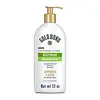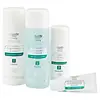What's inside
What's inside
 Key Ingredients
Key Ingredients

 Benefits
Benefits

 Concerns
Concerns

 Ingredients Side-by-side
Ingredients Side-by-side

Water
Skin ConditioningGlycerin
HumectantHydroxyethyl Urea
HumectantDimethicone
EmollientGlyceryl Stearate
EmollientPetrolatum
EmollientSteareth-21
CleansingDistearyldimonium Chloride
Jojoba Esters
EmollientAloe Barbadensis Leaf Juice
Skin ConditioningCetearyl Alcohol
EmollientBehentrimonium Methosulfate
Methyl Gluceth-20
HumectantButyrospermum Parkii Butter Extract
Skin ConditioningCamellia Sinensis Leaf Extract
AntimicrobialCitrus Aurantium Dulcis Fruit Extract
MaskingCitrus Limon Fruit Extract
MaskingPyrus Malus Fruit Extract
Skin ConditioningCucumis Sativus Extract
Skin ConditioningHelianthus Annuus Seed Extract
Skin ConditioningHordeum Vulgare Extract
EmollientSaccharum Officinarum Extract
MoisturisingHydrolyzed Jojoba Esters
Skin Conditioning3-O-Ethyl Ascorbic Acid
Skin ConditioningNiacinamide
SmoothingUbiquinone
AntioxidantTocopheryl Acetate
AntioxidantCeramide NP
Skin ConditioningCeramide Ns
Skin ConditioningCeramide Eos
Skin ConditioningCeramide EOP
Skin ConditioningCeramide AP
Skin ConditioningCaprooyl Phytosphingosine
Skin ConditioningCaprooyl Sphingosine
Skin ConditioningStearamidopropyl Pg-Dimonium Chloride Phosphate
Cetyl Alcohol
EmollientCholesterol
EmollientCeteareth-25
CleansingBehenic Acid
CleansingButylene Glycol
HumectantPropylene Glycol Dicaprate
EmollientPolysorbate 60
EmulsifyingPropylene Glycol
HumectantPotassium Hydroxide
BufferingMethylparaben
PreservativeEthylhexylglycerin
Skin ConditioningC12-15 Alkyl Benzoate
AntimicrobialEDTA
Parfum
MaskingWater, Glycerin, Hydroxyethyl Urea, Dimethicone, Glyceryl Stearate, Petrolatum, Steareth-21, Distearyldimonium Chloride, Jojoba Esters, Aloe Barbadensis Leaf Juice, Cetearyl Alcohol, Behentrimonium Methosulfate, Methyl Gluceth-20, Butyrospermum Parkii Butter Extract, Camellia Sinensis Leaf Extract, Citrus Aurantium Dulcis Fruit Extract, Citrus Limon Fruit Extract, Pyrus Malus Fruit Extract, Cucumis Sativus Extract, Helianthus Annuus Seed Extract, Hordeum Vulgare Extract, Saccharum Officinarum Extract, Hydrolyzed Jojoba Esters, 3-O-Ethyl Ascorbic Acid, Niacinamide, Ubiquinone, Tocopheryl Acetate, Ceramide NP, Ceramide Ns, Ceramide Eos, Ceramide EOP, Ceramide AP, Caprooyl Phytosphingosine, Caprooyl Sphingosine, Stearamidopropyl Pg-Dimonium Chloride Phosphate, Cetyl Alcohol, Cholesterol, Ceteareth-25, Behenic Acid, Butylene Glycol, Propylene Glycol Dicaprate, Polysorbate 60, Propylene Glycol, Potassium Hydroxide, Methylparaben, Ethylhexylglycerin, C12-15 Alkyl Benzoate, EDTA, Parfum
Allantoin
Skin ConditioningCarbomer
Emulsion StabilisingCeteareth-20
CleansingCetearyl Alcohol
EmollientCyclopentasiloxane
EmollientCyclotetrasiloxane
EmollientDiazolidinyl Urea
PreservativeDimethicone
EmollientEthoxydiglycol
HumectantParfum
MaskingGlyceryl Stearate
EmollientMethylparaben
PreservativePanthenol
Skin ConditioningPEG-100 Stearate
Propylene Glycol
HumectantPropylparaben
PreservativeWater
Skin ConditioningTriethanolamine
BufferingXanthan Gum
EmulsifyingButylene Glycol
HumectantCymbopogon Schoenanthus Extract
Skin ConditioningEthylparaben
PreservativeGeranium Maculatum Extract
TonicGlycereth-26
HumectantHydrated Silica
AbrasiveKaolin
AbrasiveLinoleic Acid
CleansingLinolenic Acid
CleansingMagnesium Aluminum Silicate
AbsorbentMelaleuca Alternifolia Leaf Oil
AntioxidantSodium Lauroyl Sarcosinate
CleansingTitanium Dioxide
Cosmetic ColorantTocopherol
AntioxidantTocopheryl Acetate
AntioxidantZinc Oxide
Cosmetic ColorantAllantoin, Carbomer, Ceteareth-20, Cetearyl Alcohol, Cyclopentasiloxane, Cyclotetrasiloxane, Diazolidinyl Urea, Dimethicone, Ethoxydiglycol, Parfum, Glyceryl Stearate, Methylparaben, Panthenol, PEG-100 Stearate, Propylene Glycol, Propylparaben, Water, Triethanolamine, Xanthan Gum, Butylene Glycol, Cymbopogon Schoenanthus Extract, Ethylparaben, Geranium Maculatum Extract, Glycereth-26, Hydrated Silica, Kaolin, Linoleic Acid, Linolenic Acid, Magnesium Aluminum Silicate, Melaleuca Alternifolia Leaf Oil, Sodium Lauroyl Sarcosinate, Titanium Dioxide, Tocopherol, Tocopheryl Acetate, Zinc Oxide
Ingredients Explained
These ingredients are found in both products.
Ingredients higher up in an ingredient list are typically present in a larger amount.
Butylene Glycol (or BG) is used within cosmetic products for a few different reasons:
Overall, Butylene Glycol is a safe and well-rounded ingredient that works well with other ingredients.
Though this ingredient works well with most skin types, some people with sensitive skin may experience a reaction such as allergic rashes, closed comedones, or itchiness.
Learn more about Butylene GlycolCetearyl alcohol is a mixture of two fatty alcohols: cetyl alcohol and stearyl alcohol. It is mainly used as an emulsifier. Emulsifiers help prevent the separation of oils and products. Due to its composition, it can also be used to thicken a product or help create foam.
Cetearyl alcohol is an emollient. Emollients help soothe and hydrate the skin by trapping moisture.
Studies show Cetearyl alcohol is non-toxic and non-irritating. The FDA allows products labeled "alcohol-free" to have fatty alcohols.
This ingredient is usually derived from plant oils such as palm, vegetable, or coconut oils. There is debate on whether this ingredient will cause acne.
Due to the fatty acid base, this ingredient may not be Malassezia folliculitis safe.
Learn more about Cetearyl AlcoholDimethicone is a type of synthetic silicone created from natural materials such as quartz.
What it does:
Dimethicone comes in different viscosities:
Depending on the viscosity, dimethicone has different properties.
Ingredients lists don't always show which type is used, so we recommend reaching out to the brand if you have questions about the viscosity.
This ingredient is unlikely to cause irritation because it does not get absorbed into skin. However, people with silicone allergies should be careful about using this ingredient.
Note: Dimethicone may contribute to pilling. This is because it is not oil or water soluble, so pilling may occur when layered with products. When mixed with heavy oils in a formula, the outcome is also quite greasy.
Learn more about DimethiconeGlyceryl Stearate is a mix of glycerin and stearic acid.
It is used to stabilize the mixing of water and oil ingredients. By preventing these ingredients from separating, it can help elongate shelf life. It can also help thicken the product's texture.
As an emollient, it helps soften skin and supports barrier-replenishing ingredients.
In cosmetics, Glyceryl Stearate is often made from vegetable oils or synthetically produced.
This ingredient may not be fungal-acne safe
Fun fact: The human body also creates Glyceryl Stearate naturally.
Learn more about Glyceryl StearateMethylparaben is a preservative and is a paraben. It is used to prevent the growth of fungus, mold, and other harmful bacteria. Parabens are chemicals used as preservatives in both cosmetics and food.
Methylparaben can be synthetically created. It can also be found naturally in some fruits, such as blueberries.
Oftentimes, Methylparaben is combined with other parabens to help increase the shelf life.
The safety of Methylparaben is currently being studied. While ongoing studies are looking into the safety of parabens, the results have been very mixed. Some studies have not found Methylparaben to be harmful.
Learn more about MethylparabenParfum is a catch-all term for an ingredient or more that is used to give a scent to products.
Also called "fragrance", this ingredient can be a blend of hundreds of chemicals or plant oils. This means every product with "fragrance" or "parfum" in the ingredients list is a different mixture.
For instance, Habanolide is a proprietary trade name for a specific aroma chemical. When used as a fragrance ingredient in cosmetics, most aroma chemicals fall under the broad labeling category of “FRAGRANCE” or “PARFUM” according to EU and US regulations.
The term 'parfum' or 'fragrance' is not regulated in many countries. In many cases, it is up to the brand to define this term.
For instance, many brands choose to label themselves as "fragrance-free" because they are not using synthetic fragrances. However, their products may still contain ingredients such as essential oils that are considered a fragrance by INCI standards.
One example is Calendula flower extract. Calendula is an essential oil that still imparts a scent or 'fragrance'.
Depending on the blend, the ingredients in the mixture can cause allergies and sensitivities on the skin. Some ingredients that are known EU allergens include linalool and citronellol.
Parfum can also be used to mask or cover an unpleasant scent.
The bottom line is: not all fragrances/parfum/ingredients are created equally. If you are worried about fragrances, we recommend taking a closer look at an ingredient. And of course, we always recommend speaking with a professional.
Learn more about ParfumPropylene Glycol is an odorless, colorless liquid. As a humectant, it helps skin retain moisture. It also aids in delivering active ingredients.
Another role of this ingredient is preventing a product from melting or freezing. Propylene glycol also adds antimicrobrial properties to a product, elongating product lifespan.
This ingredient is considered an organic alcohol and commonly added into both cosmetics and foods.
Those with sensitive skin or conditions may develop a rash when using this ingredient.
Learn more about Propylene GlycolTocopheryl Acetate is AKA Vitamin E. It is an antioxidant and protects your skin from free radicals. Free radicals damage the skin by breaking down collagen.
One study found using Tocopheryl Acetate with Vitamin C decreased the number of sunburned cells.
Tocopheryl Acetate is commonly found in both skincare and dietary supplements.
Learn more about Tocopheryl AcetateWater. It's the most common cosmetic ingredient of all. You'll usually see it at the top of ingredient lists, meaning that it makes up the largest part of the product.
So why is it so popular? Water most often acts as a solvent - this means that it helps dissolve other ingredients into the formulation.
You'll also recognize water as that liquid we all need to stay alive. If you see this, drink a glass of water. Stay hydrated!
Learn more about Water